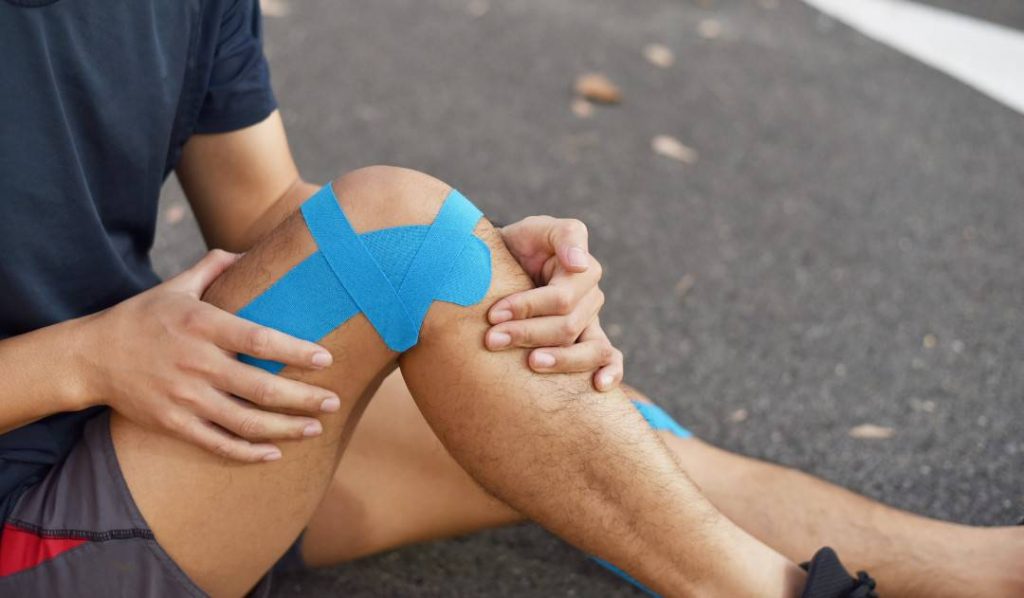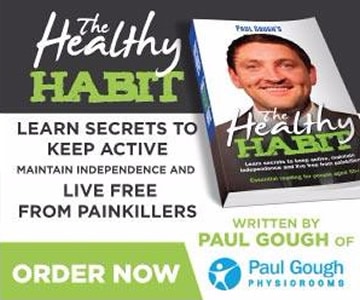Are you dealing with an injury to your shoulder, knee, or back from exercise?
We know that recovering from a strain or sprain is often a long road.
It can take time and lots of trial and error to get you back to the level of activity you used to have which can feel never-ending.
However, taping is a solution you may not have considered before but has been used for decades in physical therapy, and by athletes as a way to speed up recovery and support weakened muscles.
So what exactly is taping and how does it work?
In this post, you’ll learn more about the details of taping and the powerful benefits it can provide in aiding your recovery from a wide range of different types of injuries.
What Is Taping?
Taping has become an increasingly popular way to aid in injury recovery for athletes and recreational exercisers alike.
Taping is the process where adhesive tape is applied around a joint or group of muscles to create extra support for the injured area.
The tape essentially keeps the joint held in place even if you are still moving around and carrying on with your exercise routine.
How Can Taping Aid In Recovery From Injury?
Give You Confidence
Taping is a fantastic way to give yourself confidence when recovering from an injury.
Due to the tape holding everything in place, you can move around and still keep up low-impact activity while you’re recovering without the risk of causing further injury.
When the tape is applied and you’re moving around, you may notice the tape tug slightly or become uncomfortable when you move the injured joint a certain way.
This is the tape giving you a warning that you’ve moved the joint too far or too harshly, this is a fantastic safety net to know when you’re overdoing your exercise.
Keeps Everything In Place
As mentioned earlier, the tape is positioned to keep the injured muscle or joint in place while you’re still able to move around.
Giving your body this extra support, allows your body to recover faster, reduce swelling and prevent movement patterns that could injure your body more.
For example, a shoulder injury could have been caused by lifting something heavy at an awkward angle. The tape will allow you to identify the pattern that caused the injury by tugging at your skin so you can alter how you lift heavy objects to prevent further injury.
Return To Activity Quicker
If you’ve experienced a strain or sprain, it’s likely you’ve been told you need to rest and you shouldn’t do any strenuous exercise until your body has healed.
With taping, you can return to low-impact exercise much quicker than if you allowed your injury to heal without the extra support that the tape gives you.
It Can Be Used Alongside Other Treatments
On its own, taping only has so many short-term benefits.
However, when coupled with other treatment options such as strengthening exercises, taping can become an even more powerful tool to give you an even more proactive recovery where you don’t have to be told to rest.
Right Now…
If you’ve read this far and you think taping could be the answer you’ve been looking for to get you back into exercise quicker and recover faster, we currently offer taping in the Physio Rooms!
You may be wondering if taping is the right treatment option for your particular injury, why not arrange one of our free taping telephone consultations to get the answer to your question?
During one of our free taping telephone consultations, you can speak to one of our physiotherapists who will be happy to answer your questions, provide you with the information you need and make sure you feel confident about taping.
Arrange your free taping telephone consultation by filling in our simple web form or if you prefer, you can call us on 01429 866 771 and a member of the team will be happy to arrange your free telephone consultation at a time that suits you.
Other Free Resources To Help With Injury Recovery
If you’re not quite ready to talk to us yet, why not download our free sports injury report to discover 7 secret recovery strategies only pro athletes know and use to make sure you can get fit and stay fit?
Download Your Free Sports Injury Report Here.
Read Our Blog – How To Stop Lower Back Pain After Golf
Read Our Blog – How To Reduce Knee Pain When Cycling – Plus 7 Easy Exercises To Keep You In The Saddle
Want videos on demand? Check Out Our YouTube Channel (Remember to hit subscribe so you don’t miss out on our new videos!)
On social media? Follow us on Facebook, Instagram or LinkedIn


